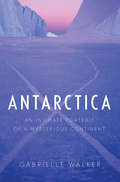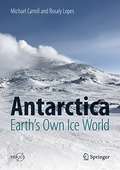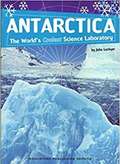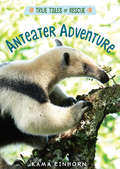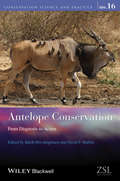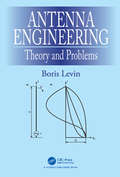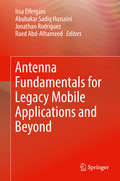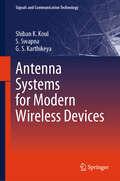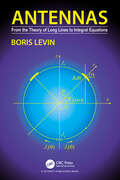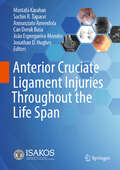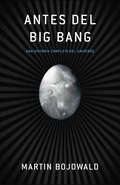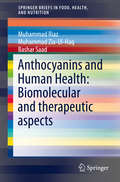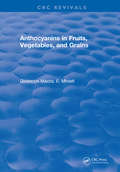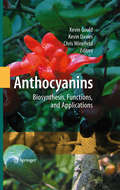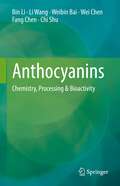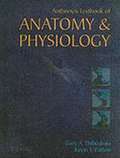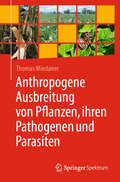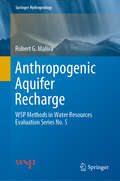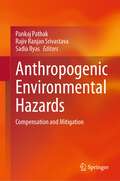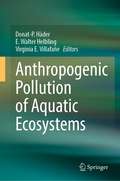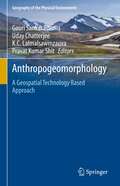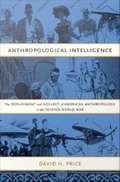- Table View
- List View
Antarctica: A Year of Science
by Jeffrey B. Fuerst Racheal RiceThe continent of Antarctica is a cold and dangerous place, with towering glaciers and deep crevasses. In the summer, temperatures reach highs of only 2 degrees Celsius (36 degrees Fahrenheit), while during the winter, temperatures can reach lows of -60 degrees Celsius (-76 degrees Fahrenheit). Yet every year a few hundred scientists brave the elements to conduct important scientific research. What does it take to make the trip--and survive the winter--in Antarctica? (Set of 6 with Teacher's Guides and Text Evidence Question Card)
Antarctica: An Intimate Portrait of a Mysterious Continent
by Gabrielle WalkerThe acclaimed science writer presents a wide-ranging exploration of Antarctica&’s history, nature, and global significance in this &“rollicking good read&” (Kirkus). From the early expeditions of Ernest Shackleton to David Attenborough&’s documentary series Frozen Planet, the continent of Antarctica has captured the world&’s imagination. After the Antarctic Treaty of 1961, decades of scientific research revealed the true extent of its many mysteries. Now former Nature magazine staff writer Gabrielle Walker tells the full story of Antarctica—from its fascinating history to its uncertain future and the international teams of researchers who brave its forbidding climate. Drawing on her broad travels across the continent, Walker weaves all the significant threads of life on the vast ice sheet into a multifaceted narrative, illuminating what it really feels like to be there and why it draws so many different kinds of people. She chronicles cutting-edge science experiments, visits to the South Pole, and unsettling portents about our future in an age of global warming. &“We are all anxious Antarctic watchers now, and Walker's book is the essential primer.&”—The Guardian, UK
Antarctica: Earth's Own Ice World (Springer Praxis Books)
by Michael Carroll Rosaly LopesIn 2016, scientist Rosaly Lopes and artist Michael Carroll teamed up as fellows of the National Science Foundation to travel to Mount Erebus, the world’s southernmost active volcano in Antarctica. The logistics of getting there and complex operations of Antarctica's McMurdo Station echo the kinds of strategies that future explorers will undertake as they set up settlements on Mars and beyond. This exciting popular-level book explores the arduous environment of Antarctica and how it is similar to other icy worlds in the Solar System.The bulk of this story delves into Antarctica’s infrastructure, exploration, and remote camps, culminating on the summit of Erebus. There, the authors explored the caves and ice towers on the volcano’s flanks, taking photographs and generating original art depicting scenes in Antarctica and terrestrial analogs on other planets and moons. Readers will see an intimate side of Mount Erebus and Antarctica while surveying the region’s history, exploration, geology, and volcanology, which includes research funded by the National Science Foundation’s United States Antarctic Programs. Richly illustrated with photographs and stunning paintings showcasing the beauty of the harsh continent, the book captures the spirit and splendor of the authors’ journey to Erebus.
Antarctica: The World's Coolest Science Laboratory
by John LockyerAntarctica: The World's Coolest Science Laboratory by John Lockyer.
Anteater Adventure (True Tales of Rescue)
by Kama EinhornAn up‑close look at what life is like the morning after a terrible hurricane for anteater Abi in this photo‑packed series exploring the stories and science behind animal sanctuaries. Abi takes readers behind the scenes of an anteater sanctuary in Belize in this nonfiction chapter book for elementary‑aged readers. Includes full‑color photos, graphics, and maps.
Antelope Conservation: From Diagnosis to Action
by Jakob Bro-Jorgensen David P. MallonFirst global comprehensive review of this ecologically diverse set of species Conservation of antelopes who serve as prey is critical to ensure conservation of corresponding predator species Ecological diverity of these species ensures that conservation issues from Antelopes can be easily applied to other species Includes state of the art approaches such as molecular techniques and the application of landscape genetics
Antenna Architectures for Future Wireless Devices (Signals and Communication Technology)
by Shiban Kishen Koul Karthikeya G. S.This book presents the design requirements of antenna integration for modern commercial devices such as smartphones, dongles, and access points. Practical use-case scenarios of smartphone and the design process of the antenna system for the same are highlighted. The feasibility of scaling up sub-6GHz to mmWave antennas is also discussed in detail followed by a plethora of design examples which could be panel mounted to modern-day commercial smartphones. The unique requirement of gain switchability is introduced with feasible practical antenna designs. High efficiency antennas for 5G base stations is introduced along with a design example on planar all-metallic antenna. Beam switchability requirement for base station is illustrated with a couple of compact antenna system examples. Variety of feeding techniques for mmWave antennas is elaborated in this book. Finally, low-cost antenna designs for future wireless devices are illustrated.
Antenna Engineering: Theory and Problems
by Boris LevinThe book deals with theoretical and experimental research of antennas. The presentation is based on the electromagnetic theory. It begins with the theory of thin antennas. Thin antennas represent one of the main types of radiators, thus the theory of thin antennas is the basis of the antennas analysis. Special attention is paid to the integral equation of Leontovich-Levin for a current along a straight thin-walled metal cylinder, which is equivalent to the equation of Hallen with a precise kernel. Together with the analysis of various types of antennas, the book deals with the problems of synthesis including the creation a wide-band radiator by means of determining of the types and the magnitudes of concentrated loads, which are connected along a linear radiator and create in a given frequency band high electrical performance. Problems of antenna engineering are discussed in the second half of the book, including the results of application of a compensation method for the protection of humans against irradiation and structural features of ship antennas.
Antenna Fundamentals for Legacy Mobile Applications and Beyond
by Jonathan Rodriguez Issa Elfergani Abubakar Sadiq Hussaini Raed Abd-AlhameedThis book highlights technology trends and challenges that trace the evolution of antenna design, starting from 3rd generation phones and moving towards the latest release of LTE-A. The authors explore how the simple monopole and whip antenna from the GSM years have evolved towards what we have today, an antenna design that is compact, multi-band in nature and caters to multiple elements on the same patch to provide high throughput connectivity. The scope of the book targets a broad range of subjects, including the microstrip antenna, PIFA antenna, and the monopole antenna to be used for different applications over three different mobile generations. Beyond that, the authors take a step into the future and look at antenna requirements for 5G communications, which already has the 5G drive in place with prominent scenarios and use-cases emerging. They examine these, and put in place the challenges that lie ahead for antenna design, particularly in mm-Wave design. The book provides a reference for practicing engineers and under/post graduate students working in this field.
Antenna Systems for Modern Wireless Devices (Signals and Communication Technology)
by Shiban K. Koul S. Swapna G. S. KarthikeyaThis book presents up-to-date information about WLAN antenna designs for students, researchers, and professionals who want to design radiating systems to be deployed for practical coverage. The book primarily focuses on pattern diversity antennas. Pattern diversity antennas are very vital in wireless communication. High correlation between multiple signals can result in low data throughput which can be solved by using antennas with pattern diversity. Beam scanning antennas and their variants are also described in detail. Pattern diversity antenna systems with multiport feeds are also comprehensively discussed in this book. For a multiport system to maintain a reasonable link budget, equal antenna gains are preferred for the required antenna coverage. The book further describes the latest techniques to enhance and equalize the antenna gain within a compact radiating system. With increasing demand for faster connectivity with minimum path loss, the demand for high-gain antennas is rapidly increasing. Thereby a detailed discussion on gain enhancement with the latest high-gain antenna designs is requisite while describing WLAN antennas. Some antenna designs discussed in the book are based on additive manufacturing for their design and fabrication. Additive manufacturing is a much sought-after technology today that allows rapid development of antennas at an affordable cost. Many recent WLAN antennas make use of this technology to develop versatile antenna designs. Finally, the book includes a section on wide-band antenna designs. Antenna designs that reduce the scanning loss are also discussed.
Antennas: From the Theory of Long Lines to Integral Equations
by Boris LevinThis book describes both known and new results. In the sections devoted to the use of integral equations for the current in a linear metal radiator, the focus is on Leontovich's equation. An advantage of this equation is the simplicity of the solution and the absence of the argument φ in it because the integration over φ already performed. The refined solution makes it possible to determine the total sum of the series for the current, which is close to the known solution including only the first terms. The results of the synthesis of different types of antennas with capacitive loads are presented, which makes it possible to implement Hallen's hypothesis about the usefulness of applying such loads to create an in-phase current distribution in antennas and to obtain required characteristics.New results include the widespread use of the complex potential method in relation to the calculation of capacitive structures in homogeneous and inhomogeneous media, antenna patterns and flows of electrical fields between antenna elements and in the surrounding space. In particular, the analysis of field flows makes it possible to substantiate a rigorous method for analyzing microstrip antennas. The characteristics of antennas in various conditions of their installation are considered and compared. The results of the use of multi-floors structures that provide in the wide frequency range the radiation in direction perpendicular to the antenna axis, and structures that make it possible to reduce the mutual influence of antennas located at different heights on a common mast are described.
Anterior Cruciate Ligament Injuries Throughout the Life Span
by Mustafa Karahan João Espregueira-Mendes Annunziato Amendola Sachin R. Tapasvi Can Doruk Basa Jonathan D. HughesThis book uniquely addresses anterior cruciate ligament (ACL) injury – one of the leading issues in orthopedic sports medicine – throughout the lifespan, with a focus on differences depending on age and activity levels.It provides readers with fundamental knowledge, such as anatomy histology and biomechanics, as well as with diagnostic criteria specific for each age group and activity level – from pediatrics through adolescents to adults and high-level athletes. Furthermore, international experts present diverse prevention and injury management criteria as well as state-of-the-art surgical techniques based on the expectations of each age and lifestyle group. Designed to be an easy-to-read reference guide, this book presents fundamental concepts in the management of ACL injuries. It appeals to a broad readership ranging from orthopedic surgeons, residents and sports physicians to athletic trainers and all professionals involved in rehabilitation following ACL injuries.
Antes del Big Bang
by Martin BojowaldEn su conocida obra Historia del tiempo, Stephen Hawking afirmaba que preguntar qué había antes del origen del universo es tan absurdo como preguntar qué hay al norte del polo Norte. Desde Einstein, el big bang era la última frontera que ningún físico se atrevía a cruzar. Incluso para la teoría general de la relatividad ese punto es considerado una singularidad que no se puede calcular y cuyas reglas físicas no están definidas. Es el punto en que comienza para nosotros el universo.Pese a todo ello, seguimos haciéndonos la misma pregunta: ¿Qué había antes del big bang? ¿Cómo nació el universo?El joven físico Martin Bojowald da respuesta gráficamente y sin fórmulas. Sus descubrimientos asombrosos sobre un mundo desconocido y emocionante, con tiempo negativo, inversión de la orientación espacial y un cosmos que se contrae para expandirse después del big bang actualizan viejos modelos cosmológicos sobre los ciclos de expansión y colapso del universo.«Bojowald consigue lo que Einstein y sus sucesores no consiguieron: llegar al punto temporal cero.»Wissenschaft im Brennpunkt
Anthocyanins and Human Health: Biomolecular and therapeutic aspects (SpringerBriefs in Food, Health, and Nutrition #0)
by Bashar Saad Muhammad Zia Ul Haq Muhammad RiazThis Brief presents comprehensive coverage of anthocyanins. The text covers the scientific literature and clinical significance of this Flavonoid sub-group, with a special focus on their therapeutic aspects. In focusing on secondary metabolites in plants, this work aims to cover the resulting therapeutic potential for humans by referencing the numerous herbal-derived substances which have been evaluated and the rapidly growing data on the interactions of anthocyanins with the microbiome. Anthocyanins and Human Health: Biomolecular and therapeutic aspects covers all angles of biomolecular, in vitro and in vivo anthocyanins from their general chemical structure to their use as a coloring agent. The intake, metabolism and secretion of anthocyanins in the human body are covered in-depth, as are the biosynthetic pathways through which these compounds are synthesized in the natural system. Factors affecting stability and extraction are listed, and health related uses and biological activities are covered in great detail. Present and future trends in anthocyanins research are also presented.
Anthocyanins in Fruits, Vegetables, and Grains: G. Mazza, Enrico Miniati
by Giuseppe MazzaThis text is a comprehensive reference covering the chemistry, physiology, chemotaxonomy, biotechnology and food technology aspects of the anthocyanins. Topics discussed include types of anthocyanins, structural transformations, colour stabilization and intensification factors, biosynthesis and intensification factors, biosynthesis, analysis and functions of anthocyanins. An in-depth review of the literature discussing anthocyanins of fruits, cereals, legumes, roots, tubers, bulbs, cole crops, oilseeds, herbs, spices, and minor crops is included as well
Anthocyanins: Biosynthesis, Functions, and Applications (Advances In Botanical Research Ser. #Volume 37)
by Kevin Gould Kevin M Davies Chris WinefieldIn recent years there has been an unprecedented expansion of knowledge about anthocyanins pigments. Indeed, the molecular genetic control of anthocyanins biosynthesis is now one of the best understood of all secondary metabolic pathways. There have also been substantial improvements in analytical technology that have led to the discovery of novel anthocyanin compounds. Armed with this knowledge and the tools for genetic engineering, plant breeders are now introducing vibrant new colors into horticultural crops. The food industry has also benefited from the resurgence of interest in anthocyanins. A greater understanding of the chemistry of these pigments has led to improved methods for stabilizing the color of anthocyanins extracts, so that they are more useful as food colorings. Methods for the bulk production of anthocyanins from cell cultures have been optimized for this purpose. Possible benefits to human health from the ingestion of anthocyanin-rich foods have also been a major feature of the recent scientific literature. Anthocyanins are remarkably potent antioxidants, and their ingestion has been postulated to stave off the effects of oxidative stress. These pigments, especially in conjunction with other flavonoids, have been associated with reductions in the incidence and severity of many other non-infectious diseases, including diabetes, cardiovascular disease and certain cancers. An industry is developing around anthocyanins as nutritional supplements. Finally, there has been significant progress in our understanding of the benefits of anthocyanins to plants themselves. Originally considered an extravagance without a purpose, anthocyanins are now implicated in multifarious vital functions. These include the attraction of pollinators and frugivores, aposematic defense from herbivores, and protection from environmental stressors such as strong light, UVB, drought, and free radical attacks. Anthocyanins are evidently highly versatile, and enormously useful to plants. This book covers all aspects of the biosynthesis and function of anthocyanins (and related compounds such as proanthocyanidins) in plants, and their applications in agriculture, food products, and human health. Featured areas include their relevance to: * Plant stress * Flower and fruit color * Human health * Wine quality and health attributes * Food colorants and ingredients * Cell culture production systems * The pastoral sector
Anthocyanins: Chemistry, Processing & Bioactivity
by Bin Li Fang Chen Wei Chen Li Wang Weibin Bai Chi ShuThis book summarizes the current knowledge of anthocyanins, provides systematic information for future exploration of anthocyanin applications. It focuses on several aspects regarding the studying progression in the field of anthocyanins. The first section of the book provides a brief introduction to the scope and progress on anthocyanins, which is followed by the second section that describes the natural sources, structure, extraction approaches, bioavailability, and current stabilizing approach of anthocyanins. Then in the third part, the book focuses on the industrial processing of anthocyanins in foods by discussing the impact of food processing on anthocyanin structure and composition as well as classical processing techniques on anthocyanin-containing foods, including high-pressure, encapsulation, microwave, and combined application of the above techniques. In the last section of the book, the authors explore the currently most popular application of anthocyanins in improving human health, such as the effect of anthocyanin on vision, metabolism, neural system, cardiovascular system, and cancers. The book will facilitate readers’ understanding of the progress of anthocyanin studies. And it will benefit researchers and graduate students in the fields of natural products, functional food, and nutrition, etc.
Anthony's Textbook of Anatomy & Physiology
by Gary A. Thibodeau Kevin T. PattonThis 17th edition of a text for courses in anatomy and physiology integrates recent discoveries on the genetic basis of body structure and function. The art program includes color dissection photos, light micrographs, and scanning and transmission electron micrographs, some new to this edition. Thibodeau is professor emeritus of biology at the University of Wisconsin; Patton teaches life science at Saint Charles Community College. Annotation (c)2003 Book News, Inc. , Portland, OR (booknews. com)
Anthony's Textbook of Anatomy and Physiology (17th Edition)
by Gary A. Thibodeau Kevin T. PattonThis is a textbook that will help students avoid becoming lost in a maze of facts in a complex learning environment. It will encourage them to explore, to question, and to look for relationships not only between related facts in a single discipline but also between fields of academic inquiry and personal experience.
Anthropogene Ausbreitung von Pflanzen, ihren Pathogenen und Parasiten
by Thomas MiedanerNoch nie sind Menschen und Waren so weit und so häufig gereist wie heute. Trotzdem spielte die Wanderung in der gesamten Geschichte der Menschheit eine große Rolle. So brachten die Bandkeramiker nicht nur die wichtigen Kulturpflanzen Weizen, Gerste, Linsen, Erbsen, Lein aus der Levante und Anatolien nach Mitteleuropa, sondern auch die Getreideroste Mehltau, Kornkäfer und Hausmaus. Ein paar Jahrtausende später kamen aus dem Osten Hirse und Hanf, Roggen und Hafer und um die Zeitenwende brachten die Römer zahlreiche neue Kulturpflanzen und Vorratsschädlinge nach Deutschland und England. Kolumbus und seine Nachfolger importierten Mais, Tomaten, Kürbis, Bohnen aus Mexiko und Kartoffeln von den Anden nach Europa und die dazu gehörigen Schädlinge kamen früher oder später nach. Der Kolonialismus wirbelte vor allem tropische Pflanzen durcheinander und heute baut Südamerika Kaffee, der ursprünglich aus Äthiopien kam, für die ganze Welt an. Seit der modernen Globalisierung cruisen ständig riesige Containerschiffe und Flugzeuge um die ganze Welt und bringen Passagiere und Fracht, aber auch Pathogene und Parasiten in die entlegensten Winkel dieser Erde. Dieses Buch zeigt die Auswirkungen weltweiter Migration von Pflanzen und die Krankheitsprobleme, die damit verbunden sind. Durch DNS-Untersuchungen können wir heute eindeutig die Herkunft von Schadpilzen und Schädlingen feststellen und erstmals ihre globale Dynamik verstehen. Gerade merken wir, dass Kulturpflanzen, Klimawandel und Krankheiten mehr miteinander zu tun haben als uns lieb ist und die Verbreitung von Krankheiten immer weiter geht. Dies bedroht auch unsere Ernten und lässt Lebensmittel teurer werden.
Anthropogenic Aquifer Recharge: WSP Methods in Water Resources Evaluation Series No. 5 (Springer Hydrogeology)
by Robert G. MalivaThe book is an overview of the diversity of anthropogenic aquifer recharge (AAR) techniques that use aquifers to store and treat water. It focusses on the processes and the hydrogeological and geochemical factors that affect their performance. This book is written from an applied perspective with a focus of taking advantage of global historical experiences, both positive and negative, as a guide to future implementation. Most AAR techniques are now mature technologies in that they have been employed for some time, their scientific background is well understood, and their initial operational challenges and associated solutions have been identified. However, opportunities exist for improved implementation and some recently employed and potential future innovations are presented. AAR which includes managed aquifer recharge (MAR) is a very important area of water resources management and there is no recent books that specifically and comprehensively addresses the subject.
Anthropogenic Environmental Hazards: Compensation and Mitigation
by Sadia Ilyas Pankaj Pathak Rajiv Ranjan SrivastavaThis book delves into the anthropogenic activities responsible for environmental hazards, their compensation, and potential mitigation strategies. It sheds light on the major contributors to the climate change issues aggravated by non-sustainable practices for the overexploitation of natural resources. Critical topics such as high emissions in primary mining, the recovery of energy-critical metals by urban mining, solid waste management, and forest conservation are explored, offering insights into the urgent challenges we face.Amidst the rapid demand for resources and the expansion of human habitats, the book emphasizes the need for new approaches to natural resource management and introspection of our actions. Experts in the field discuss existing anthropogenic environmental hazards in detail, alongside environmental compensation, and effective mitigation approaches.The book begins with a chapter dedicated to risk assessment in primary mining activities for precious metals, proposing potential routes for mitigation. Chapter 2 focuses on assessing and mitigating the environmental footprints of energy-critical metals used in permanent magnets. In Chapter 3, a case study examines sustainable resource utilization through end-of-life room air conditioner recycling. Additional chapters provide critical insights into:The environmental impacts of e-waste and government policies for responsible managementHazards associated with industrial effluents and corresponding mitigation strategiesThe role of roadside plants in phytoremediation of heavy metal pollutionSustainable utilization of anthropogenic coal fly ash through mechanical and chemical activationEnvironmental damages resulting from the mismanagement of municipal solid wasteEnvironmental problems and remediation strategies for anthropogenic biomass wasteChallenges in sustainable municipal solid waste management and suggestions for environmental risk mitigation The book concludes with a chapter discussing collaborative governance and non-monetary compensation mechanisms for sustainable forest management. Given its breadth, this book serves as an indispensable resource for researchers, policymakers, and environmental professionals seeking sustainable approaches to tackle pressing environmental challenges.
Anthropogenic Pollution of Aquatic Ecosystems
by Donat-P. Häder E. Walter Helbling Virginia E. VillafañeThis book provides examples of pollutants, such as accidental oil spills and non-degradable plastic debris, which affect marine organisms of all taxa. Terrestrial runoff washes large amounts of dissolved organic materials from agriculture and industry, toxic heavy metals, pharmaceuticals, and persistent organic pollutants which end up into rivers, coastal habitats, and open waters. While this book is not intended to encyclopaedically list all kinds of pollution, it rather exemplifies the problems by concentrating on a number of serious and prominent recent developments. The chapters in this book also discuss measures to decrease and remove aquatic pollution to mitigate the stress on aquatic organisms. Aquatic ecosystems provide a wide range of ecological and economical services. In addition to providing a large share of the staple diet for a fast growing human population, oceans absorb most of the anthropogenically emitted carbon dioxide and mitigate climate change. As well as rising temperatures and ocean acidification, pollution poses increasing problems for aquatic ecosystems and organisms reducing its functioning and services which are exposed to a plethora of stress factors.
Anthropogeomorphology: A Geospatial Technology Based Approach (Geography of the Physical Environment)
by Gouri Sankar Bhunia Pravat Kumar Shit Uday Chatterjee K. C. LalmalsawmzauvaThis book explores state-of-art techniques based on open-source software and statistical programming and modelling in modern geospatial applications, specifically focusing on recent trends in data mining techniques and robust modelling in Geomorphological, Hydrological, Bio-physical and Social activities. The book is organized into physical, mountainous, coastal, riverine, forest, urban and biological activities, with each chapter providing a review of the current knowledge in the focus area, and evaluating where future efforts should be directed. The text compiles a collection of recent developments and rigorous applications of Geospatial computational intelligence (e.g., artificial neural network, spatial interpolation, physical and environmental modelling and machine learning algorithms etc) in geomorphic processes from a team of expert contributors. The authors address the wide range of challenges and uncertainties in the study of earth system dynamics due to climate change, and complex anthropogenic interferences where spatial modelling may be applied in the risk assessment of vulnerable geomorphological landscapes. The book will act as a guide to find recent advancements in geospatial artificial intelligence techniques and its application to natural and social hazards. This information will be helpful for students, researchers, policy makers, environmentalists, planners involved in natural hazard and disaster management, NGOs, and government organizations.
Anthropological Intelligence: The Deployment and Neglect of American Anthropology in the Second World War
by David H. PriceBy the time the United States officially entered World War II, more than half of American anthropologists were using their professional knowledge and skills to advance the war effort. The range of their war-related work was extraordinary. They helped gather military intelligence, pinpointed possible social weaknesses in enemy nations, and contributed to the army's regional Pocket Guide booklets. They worked for dozens of government agencies, including the Office of Strategic Services (OSS) and the Office of War Information. At a moment when social scientists are once again being asked to assist in military and intelligence work, David H. Price examines anthropologists' little-known contributions to the Second World War. Anthropological Intelligence is based on interviews with anthropologists as well as extensive archival research involving many Freedom of Information Act requests. Price looks at the role played by the two primary U. S. anthropological organizations, the American Anthropological Association and the Society for Applied Anthropology (which was formed in 1941), in facilitating the application of anthropological methods to the problems of war. He chronicles specific projects undertaken on behalf of government agencies, including an analysis of the social effects of postwar migration, the design and implementation of OSS counterinsurgency campaigns, and the study of Japanese social structures to help tailor American propaganda efforts. Price discusses anthropologists' work in internment camps, their collection of intelligence in Central and South America for the FBI's Special Intelligence Service, and their help forming foreign language programs to assist soldiers and intelligence agents. Evaluating the ethical implications of anthropological contributions to World War II, Price suggests that by the time the Cold War began, the profession had set a dangerous precedent regarding what it would be willing to do on behalf of the U. S. government.

